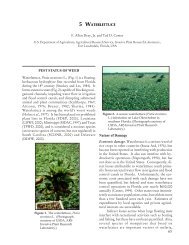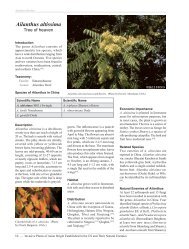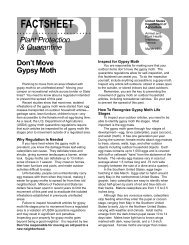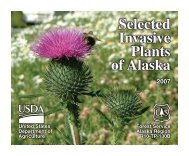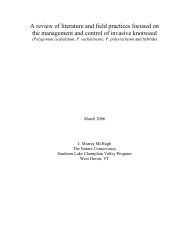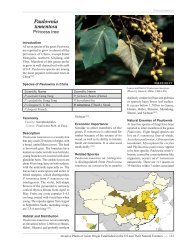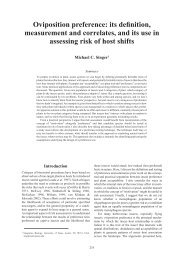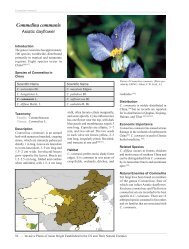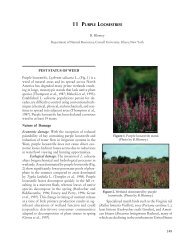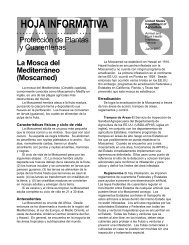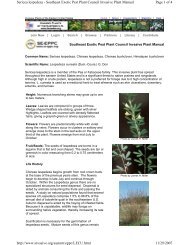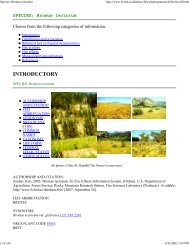A Guide to the Control and Management of Invasive Phragmites [PDF]
A Guide to the Control and Management of Invasive Phragmites [PDF]
A Guide to the Control and Management of Invasive Phragmites [PDF]
You also want an ePaper? Increase the reach of your titles
YUMPU automatically turns print PDFs into web optimized ePapers that Google loves.
underst<strong>and</strong>ing phragmites<br />
control methods<br />
recommended management strategies<br />
fur<strong>the</strong>r information<br />
part 1<br />
part 2<br />
part 3<br />
part 4<br />
17<br />
In Michigan, mowing <strong>and</strong> cutting<br />
phragmites below <strong>the</strong> ordinary<br />
high-water mark <strong>of</strong> <strong>the</strong> Great Lakes<br />
<strong>and</strong> Lake St. Clair requires a permit<br />
from <strong>the</strong> MDEQ, L<strong>and</strong> <strong>and</strong> Water<br />
Mechanical Treatment<br />
Mechanical treatments are used most effectively following an<br />
herbicide treatment <strong>to</strong> remove dead stems <strong>and</strong> promote native plant<br />
growth. This also aids in <strong>the</strong> identification <strong>of</strong> new phragmites<br />
growth for subsequent herbicide spot treatments. When burning<br />
is not feasible, mechanical treatment is recommended.<br />
<strong>Management</strong> Division.<br />
Permit applications can be obtained<br />
from <strong>the</strong> MDEQ website at<br />
http://www.michigan.gov/<br />
deqwetl<strong>and</strong>s. Mowing st<strong>and</strong>s <strong>of</strong><br />
phragmites in inl<strong>and</strong> wetl<strong>and</strong>s may also<br />
require a permit. Before initiating any<br />
cutting or mowing regimen, contact <strong>the</strong><br />
MDEQ EAC at 1-800-662-9278<br />
for more information about L<strong>and</strong> <strong>and</strong><br />
Water <strong>Management</strong> permits.<br />
left: Using a brush hog <strong>to</strong> mechanically<br />
remove dead phragmites stems after an<br />
herbicide treatment; St. Clair Flats<br />
Wildlife Area, MI. J. Schafer<br />
Mechanical treatment should be limited<br />
<strong>to</strong> only those areas where phragmites is<br />
present, <strong>and</strong> should not include broadscale<br />
mowing <strong>of</strong> o<strong>the</strong>r wetl<strong>and</strong> vegetation.<br />
Mechanical control <strong>of</strong> phragmites<br />
includes <strong>the</strong> use <strong>of</strong> weed whips, small<br />
mowers, brush hogs, <strong>and</strong> flail mowers or<br />
h<strong>and</strong>-cutting <strong>of</strong> stems <strong>and</strong> seed heads.<br />
The use <strong>of</strong> mechanical equipment is<br />
highly dependent on <strong>the</strong> size <strong>and</strong> wetness<br />
<strong>of</strong> <strong>the</strong> site <strong>and</strong> <strong>the</strong> density <strong>of</strong> phragmites.<br />
Weed whips or h<strong>and</strong>held cutting <strong>to</strong>ols are<br />
ideal for use on wet or dry sites with low<br />
plant densities. Small mowers can be<br />
used effectively on low density sites.<br />
Larger mowers can be used on sites with<br />
a higher density <strong>of</strong> plants, but <strong>the</strong> site<br />
must be dry enough <strong>to</strong> support <strong>the</strong><br />
weight <strong>of</strong> <strong>the</strong> mower in order <strong>to</strong> avoid<br />
soil disturbance.<br />
If mechanical treatment methods are<br />
chosen as part <strong>of</strong> a phragmites management<br />
plan, it is critical <strong>to</strong> adhere <strong>to</strong> <strong>the</strong><br />
following timing recommendations.<br />
Mechanical treatments should not occur<br />
until at least 2 weeks after herbicide<br />
treatment <strong>to</strong> allow plant absorption <strong>of</strong><br />
<strong>the</strong> herbicide. To remove dead stems on<br />
dry sites after an herbicide treatment,<br />
mechanically cut <strong>the</strong> treated plants once<br />
within a period from late summer or fall<br />
until prior <strong>to</strong> spring green-up. On wet<br />
sites, mechanically cut <strong>the</strong> treated plants<br />
once when <strong>the</strong> ground is frozen <strong>to</strong> minimize<br />
soil disruption. Mowing/cutting<br />
should occur only during time frames<br />
that will avoid soil disturbance.<br />
Once an area has been mowed or cut,<br />
thatch should be raked, bagged <strong>and</strong> disposed<br />
<strong>of</strong> in an appropriate location <strong>to</strong><br />
prevent seed spread <strong>and</strong> <strong>to</strong> allow sunlight


![A Guide to the Control and Management of Invasive Phragmites [PDF]](https://img.yumpu.com/27321025/22/500x640/a-guide-to-the-control-and-management-of-invasive-phragmites-pdf.jpg)

